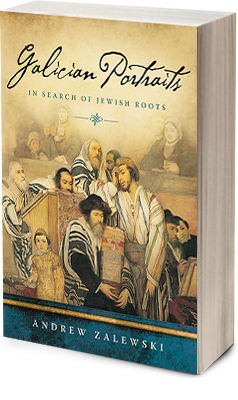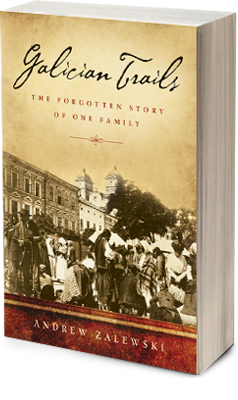About People & Places
Galician Portraits. In Search of Jewish Roots

As though walking through a portrait gallery with paintings in different styles, we encounter Jewish traditionalists and modernists. Among them are faces that disappear in the crowd and those that stand out, timid people and fearless individuals. In the background, we can hear a constant debate between those who looked to their community for a sense of fulfillment and comforting order, and others who wanted to explore new ideas.
There is a richness of spoken and written words—whether in Hebrew, Yiddish, German, or Polish—as Galician Jews debate each other with a flaming passion over which language should be theirs in that polyglot land. The author’s ancestors from the Dub and the Hübner families, common yet inspiring people, share the pages of Galician Portraits with other memorable voices of their community.
The Dub family had its roots in Rohatyn. Their story began with Samuel Dub, a house owner in this typical Galician town. His son, Sender, entered adulthood early, running herds of cattle to far-away markets in Moravia. With a bit of luck and perseverance, he became a successful businessman who invested wisely in rural estates in Galicia. Toward the end of his remarkable life, Sender presided over the Credit Association of Rohatyn. His son—another Samuel in the family tree—had three daughters. The youngest of them, Regina (the author’s future grandmother), was born in 1879. Along their multigenerational journey, the Dub family developed close bonds with the Seinfeld, Horn, Katz, and Hefler families.
The Hübner family was from Kołomyja (Kolomea), a Galician town situated not far from the adjacent Bukovina situated on the edge of the empire. Starting with Abraham at the beginning of the nineteenth century, Hübners were local merchants and house owners. The marriage between Salomon (the grandchild of Abraham) and Rachel Fränkel brought this branch of the family to the nearby rural estate owned by Rachel’s father. This union produced the author’s future grandfather, Joachim Hübner, born in 1881. Through marriages, the Hübner clan became related to the Hilsenrath, Fränkel, Goldenberg, Badian and Erbsen families.
Regina Dub and Joachim Hübner married in 1905. During World War I the family moved to Lwów. Soon, with the turmoil of the conflict behind them, the Hübners looked with optimism toward the future. They were a modern couple that focused on providing education to their two boys. Their oldest son, Zygmunt Hübner, became a successful lawyer and married an effervescent young cellist, Ewa Kuttin. The younger one—and the author’s father—Alfred Hübner also graduated with a law degree from the university in Lwów but began a career in business and corporate law. Yet when everything seemed to suggest only a bright future for the Hübner clan, their personal dreams and professional aspirations came to an abrupt halt in September 1939. The fight for the family’s survival began.
Galician Trails. The Forgotten Story of One Family

Galician Trails is the story of Poles, Ukrainians (Ruthenians), Jews, and Austrians who once lived in the small villages and towns of Galicia. In this multiethnic land, we also meet Armenians, Germans, Hungarians, and even migrants from Asia. This is the tale of Christian, Jewish, and Muslim neighbors, living side by side.
The people of Galician Trails shared a stubborn perseverance that allowed them to prevail over the adversities of the time. The big events playing out on the world stage constantly mixed with what the Galicians did in their free time or talked about around the dinner table. Time after time, the prevailing norms of that now long-gone society and our own preconceived notions about the past are challenged by the Lösches, Regiecs, Sobolewskis, and their neighbors.
The Lösch family had its roots in Austria. Their story began with a father and a son who settled in Galicia at the beginning of the nineteenth century when nothing seemed certain, with Napoleon redrawing the map of Europe. Yet one or two generations later, their descendant Andreas Lösch and his wife, Eleonora Wilczek, would live in Galicia no longer thinking about it as a temporary home. Along their life journey, they developed close bonds with the Jahl, Telesnicki, and Winkler families, whose names hint at their multiethnic origins.
The saga of the Regiec family had its distant origins in Hungary, with an oral legend about Asian blood in their veins. The Regiecs’ story stretched from the simple life of a shepherd to the memorable one of the accomplished Joseph. The lives of Joseph Regiec and his wife, Stephania Lösch, became connected with the railroads that were suddenly opening the world around them. Their daughter, the author’s grandmother, would be shaped by her own quest for independence and by circumstances that nobody was able to predict. As a result, the life of Helena Regiec, a predecessor of many modern women of today, turned out to be inspiring.
The Sobolewski family traced their roots back to sixteenth-century Poland. In ancient times, they were minor nobles who moved east to become landowners, turned farmers. The Sobolewski clan lived among their Jewish, Ukrainian (Ruthenian), Bohemian, and German neighbors (with names like Baumann, Feyerl, Ernest, Halawaj, Herman, Kühn, Martyniec, and Schüssel, to mention just a few). Theirs was a large family, which for generations remained linked to the ancestral land. But soon after Helena Regiec and Franciscus Sobolewski became married, their lives would take an unpredictable turn, during World War I and its aftermath. The unearthed tale of Helena and Franciscus is the story of personal dreams halted by events beyond their control.
The people of Galician Trails shared a stubborn perseverance that allowed them to prevail over the adversities of the time. The big events playing out on the world stage constantly mixed with what the Galicians did in their free time or talked about around the dinner table. Time after time, the prevailing norms of that now long-gone society and our own preconceived notions about the past are challenged by the Lösches, Regiecs, Sobolewskis, and their neighbors.
Places
Galician Trails takes us through the many towns of Galicia that the Lösches called home, including Andrychow, Wieliczka, Tarnow, Jaslo, Biecz, Liszki, Chrzanow, and Nowy Sacz. Our journey also passes through Cracow and Lvov.
With the Regiecs, we move from the tiny and poor Galician villages of Gierowa and Roztoka to larger places. We travel with Joseph Regiec to towns in the Duchy of Bukovina and to Vienna, the capital of Austro-Hungary. When the family settles in Stanislawow, we discover a charming city with a vibrant life. We walk with the Regiecs through the parks and streets, where the sound of Yiddish is mixed with Polish, German, and Ukrainian.
The Sobolewski family takes the reader to Bohorodczany and Lachowce, their ancestral homelands. From Austrian censuses and old cadastral maps, we re-create a precise picture of the town of Bohorodczany, passing by small shops around the market square. Continuing through the fields and along small country roads, we arrive at the family compound to discover the real-life tales told in these pages.